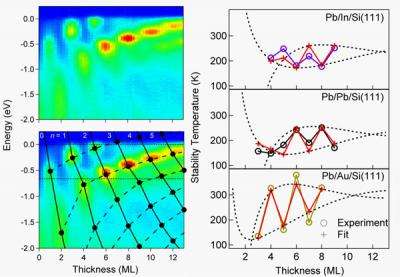Research Reveals Insight into Stability of Thin Films

Just as every snowflake is different from any other, an individual snowball exhibits exceptionally different properties than the thousands of snowflakes that make it up. A group led by Dr. Tai-Chang Chiang of the University of Illinois studies how thin films of materials—such as lead films deposited on silicon—exhibit different traits than their more massive cousins. Most recently, they have found that it is possible to turn unstable films into stable ones.
"Our results demonstrate that unstable film thicknesses can be turned into stable ones. This capability is important for developing strategies for device applications," write Dr. Chiang and his colleagues in an article in Physical Review Letters (31 December 2005). The work was also summarized recently as a research highlight in the journal Nature (12 January 2006).
"In the present work, we compare the stability properties of Pb films deposited on Pb-, In-, and Au-terminated Si surfaces," explains Dr. Chiang. The research summarizes that while odd-numbered layers of thin films are normally less stable than even-numbered ones, when a coating of a layer of indium atoms is put between lead and silicon, the odd-numbered films become more stable.

"In our research at SRC, we measure the electronic structure of films. Essentially all physical properties of materials are determined by their electronic structure. Due to quantum confinement and boundary effects, thin film electronic structure can be very different from the bulk counterpart, and likewise the properties can be substantially different and possibly useful," Chiang explains.
Indeed, it's this ability to reduce materials down to a few atoms of thickness—along with making the films as smooth as possible—that is the group's goal. "In some ways what we're trying to get is the simplest possible sample," explains Dr. Tom Miller, a member of the research team and a resident scientist at the Synchrotron Radiation Center at the University of Wisconsin, where the research was conducted. "So in a way we're trying to get the most boring sample possible!"
Yet for several years the group's progress has been anything but boring. In fact, Chiang and his colleagues have been exceptionally successful. While the work is deeply rooted in the fundamental exploration of physical properties, there are many exciting practical benefits to this research.
"Our work on atomically uniform films provides a fundamental understanding of the relationship between structure and properties based on quantum physics. Ultrathin films are important components for devices, now and future," says Chiang. "Our work on quantum well states began in the 1980's (at the Synchrotron Radiation Center). The first report of quantum well states as observed by angle-resolved photoemission appeared in 1986. My group discovered in 1998 that atomically uniform films of Ag can be prepared on Fe. In 2004, we reported that atomically uniform films of Pb and Ag can be prepared on Si and Ge; Si and Ge are the most important electronic substrate materials. The work has potential for great impact on future electronic devices."
Reference:
Ricci, D.A., Miller, T. and Chiang, T-C. Controlling the Thermal Stability of Thin Films by Interfacial Engineering. Phys. Rev. Letters 95, 266101 (2005).
Source: Synchrotron Radiation Center (by John Morgan)















